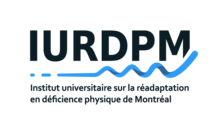
The effects of exercise in the post-stroke recovery continuum: can we promote brain plasticity and cardiovascular health?
2 mai 2024

Les effets de l'exercice dans le continuum de récupération post-AVC : pouvons-nous favoriser la plasticité cérébrale et la santé cardiovasculaire ?
Activité sur inscription offerte en ligne ET sur place à l'Institut de réadaptation Gingras-Lindsay-de-Montréal (IRGLM), Pavillon Gingras : Auditorium Charles-U Létourneau
Marc Roig Pull, Ph. D.
School of Physical and Occupational Therapy, McGill University.
Laboratoire de réadaptation de la mémoire et de la motricité (MEMORY-LAB), Centre de recherche Feil et Oberfeld, Hôpital Juif de Réadaptation,
Centre de recherche interdisciplinaire en réadaptation du Montréal métropolitain (CRIR)
Abrégé: Dans cette présentation, je vais parler de l'intégration de l'exercice cardiovasculaire en tant que stratégie pour améliorer à la fois la plasticité cérébrale et la santé cardiovasculaire chez les personnes à différents stades de récupération post-AVC. Tout d'abord, je présenterai les résultats d'un essai clinique randomisé portant sur 70 patients en phase subaiguë de l'AVC (< 3 mois post-AVC), qui montre que l'exercice cardiovasculaire a des effets profonds sur les capacités cardiorespiratoires mais des effets inconstants sur l'excitabilité cérébrale et la concentration périphérique de protéines impliquées dans la réparation neuronale et la récupération post-AVC. Ensuite, je présenterai les résultats d'un autre essai contrôlé randomisé portant sur 82 patients en phase chronique de l'AVC (> 6 mois post-AVC). Cette étude montre que l'entraînement par intervalles de haute intensité (HIIT) est une alternative efficiente à l'entraînement cardiovasculaire d'intensité modérée (MICT) pour améliorer la condition cardiorespiratoire. Je montrerai également que, contrairement à ce que nous avons observé chez les patients en phase subaiguë, l'exercice cardiovasculaire favorise des changements positifs dans l'excitabilité cérébrale chez les patients en phase chronique. À ce jour, ce sont les deux plus grandes études randomisées contrôlées explorant l'utilisation de l'exercice cardiovasculaire pour améliorer la plasticité cérébrale et la santé cardiovasculaire chez les patients à différents stades de récupération post-AVC.
Abstract: In this presentation I will talk about the implementation of cardiovascular exercise as strategy to improve brain plasticity and cardiovascular health in people at different stages of stroke recovery. First, I will present the results of one randomized controlled trial with 70 patients with subacute stroke (< 3 months post stroke) that shows that cardiovascular exercise has profound effects on cardiorespiratory fitness but inconsistent effects on brain excitability and the peripheral concentration of proteins involved in neural repair and stroke recovery. Then, I will present the results of another randomized controlled trial with 82 patients with chronic stroke (> 6 months post stroke) that shows that hight intensity interval training (HIIT) is a time efficient alternative to moderate intensity cardiovascular training (MICT) to improve cardiorespiratory fitness. I will also show that, in contrast to what we saw in subacute patients, cardiovascular exercise promotes positive changes in brain excitability in chronic patients. To date, these are the two largest randomized controlled trials exploring the use of cardiovascular exercise to improve brain plasticity and cardiovascular health in patients at different stages of stroke recovery.
Auditoire ciblé: rehabilitation students, kinesiologists, clinicians and neurocientists interested in brain plasticity and brain stimulation
Présentation offerte en anglais. Du soutien sera disponible pour traduire questions et réponses au besoin.
